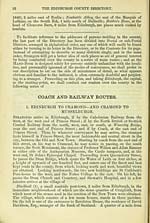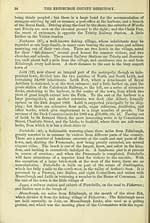Download files
Complete book:
Individual page:
Thumbnail gallery: Grid view | List view

COACH AND RAILWAY ROUTES. 23
the village, and a little to the left, is Craigcrook, the well-known residence
of the late Lord Jeffrey, in whose time it was the scene of many social
Saturday afternoon gatherings of the Edinburgh bar. Fully half-a-mile farther
on, a little to the right, is
Davidson's Mains (9), a clean little village and post-town, with a considerable
population, which was at one time called Muttonhole. It has a Free Church
and school, a subscription school, and a female parochial school. The inhabi-
tants are chiefly employed in the neighbouring farms and quarries. In the
summer, a coach (the " Jock Howieson ") rims from Edinburgh through the
village to and from Cramond twice daily. There are several large farms in
the neighbourhood. West of the village, and extending for nearly a mile, is
the Barnton estate, now one of the seats of Sir Alexander Ramsay Gibson-
Maitland, Bart., member for the county.
Cramond (6), six miles from Edinburgh, is reached from this point by the
road at Davidson's Mains, which bounds the Barnton estate on the north-east,
and along which the " Jock Howieson " runs ; but the Queensferry coach from
Edinburgh keeps the Queensferry Road, landing its passengers at Cramond
Bridge (formerly Upper Cramond), picturesquely situated on the banks of the
River Almond, which here flows through a wooded glen past the village,
till it reaches the Firth of Forth. There is a good inn at Cramond Bridge,
and also a post-office ; but the village proper is about a mile towards the
coast, which is reached by the road a little to the rigbt, forming the west
boundary of Barnton grounds, and which meets the road from Davidson's
Mains at the village. On the right, as the Visitor enters this road, is Brae-
head, gifted by the " Gudeman of Balingeigh " to John Howieson for his timely
aid in dispersing with his flail the gipsies who were likely to overmatch the
disguised Sovereign. Cramond has a parish church and school, large iron-
works, and a ship-coating company, and is beginning to be resorted to in
summer as a sea-bathing quarter by the less wealthy classes. About a mile
from the mouth of the Almond is Cramond Island, accessible on foot at low
water. It has lately been bought by the Earl of Rosebery from the laird of
Barnton. The coast-line of the county, a distance of fully twelve miles,
stretches from Cramond to Musselburgh ; and the Visitor who has time may
enjoy a beautiful drive along this route, and return to Edinburgh in good time
in the evening. Starting from Cramond, the Visitor, if on foot, may proceed
along the shore of the Firth by Broomfield, Muirhouse, and Craig Royston, to
Granton House ; but if driving, he will require to return to Davidson's Mains
by Cramond House (the residence of John C. C. Halkett, Esq.), and Laurieston
Castle, formerly possessed by the Laws of Laurieston, who lost it for their
adherence to the cause of the Stuarts, and of which George Law, founder of
the Bank of France, was at one time proprietor., A mile from Davidson's
Mains, he will turn down the road on the left, by West Pilton and Muirhouse,
pass Granton House, the residence of the Right Hon. Sir John M'Neill, and
Caroline Park, one of the seats of the Duke of Buccleuch, and arrive at
Granton (20), a spacious harbour and breakwater, the property of the Duke
of Buccleuch, where there is a large shipbuilding yard and patent slip, and also
wool-stores and iron- works. Granton is a station of the North British Rail-
way, and is the ferry to Burntisland and the North. The Caledonian Railway
has a goods station here. There are very few houses at Granton, the district
the village, and a little to the left, is Craigcrook, the well-known residence
of the late Lord Jeffrey, in whose time it was the scene of many social
Saturday afternoon gatherings of the Edinburgh bar. Fully half-a-mile farther
on, a little to the right, is
Davidson's Mains (9), a clean little village and post-town, with a considerable
population, which was at one time called Muttonhole. It has a Free Church
and school, a subscription school, and a female parochial school. The inhabi-
tants are chiefly employed in the neighbouring farms and quarries. In the
summer, a coach (the " Jock Howieson ") rims from Edinburgh through the
village to and from Cramond twice daily. There are several large farms in
the neighbourhood. West of the village, and extending for nearly a mile, is
the Barnton estate, now one of the seats of Sir Alexander Ramsay Gibson-
Maitland, Bart., member for the county.
Cramond (6), six miles from Edinburgh, is reached from this point by the
road at Davidson's Mains, which bounds the Barnton estate on the north-east,
and along which the " Jock Howieson " runs ; but the Queensferry coach from
Edinburgh keeps the Queensferry Road, landing its passengers at Cramond
Bridge (formerly Upper Cramond), picturesquely situated on the banks of the
River Almond, which here flows through a wooded glen past the village,
till it reaches the Firth of Forth. There is a good inn at Cramond Bridge,
and also a post-office ; but the village proper is about a mile towards the
coast, which is reached by the road a little to the rigbt, forming the west
boundary of Barnton grounds, and which meets the road from Davidson's
Mains at the village. On the right, as the Visitor enters this road, is Brae-
head, gifted by the " Gudeman of Balingeigh " to John Howieson for his timely
aid in dispersing with his flail the gipsies who were likely to overmatch the
disguised Sovereign. Cramond has a parish church and school, large iron-
works, and a ship-coating company, and is beginning to be resorted to in
summer as a sea-bathing quarter by the less wealthy classes. About a mile
from the mouth of the Almond is Cramond Island, accessible on foot at low
water. It has lately been bought by the Earl of Rosebery from the laird of
Barnton. The coast-line of the county, a distance of fully twelve miles,
stretches from Cramond to Musselburgh ; and the Visitor who has time may
enjoy a beautiful drive along this route, and return to Edinburgh in good time
in the evening. Starting from Cramond, the Visitor, if on foot, may proceed
along the shore of the Firth by Broomfield, Muirhouse, and Craig Royston, to
Granton House ; but if driving, he will require to return to Davidson's Mains
by Cramond House (the residence of John C. C. Halkett, Esq.), and Laurieston
Castle, formerly possessed by the Laws of Laurieston, who lost it for their
adherence to the cause of the Stuarts, and of which George Law, founder of
the Bank of France, was at one time proprietor., A mile from Davidson's
Mains, he will turn down the road on the left, by West Pilton and Muirhouse,
pass Granton House, the residence of the Right Hon. Sir John M'Neill, and
Caroline Park, one of the seats of the Duke of Buccleuch, and arrive at
Granton (20), a spacious harbour and breakwater, the property of the Duke
of Buccleuch, where there is a large shipbuilding yard and patent slip, and also
wool-stores and iron- works. Granton is a station of the North British Rail-
way, and is the ferry to Burntisland and the North. The Caledonian Railway
has a goods station here. There are very few houses at Granton, the district
Set display mode to: Large image | Transcription
Images and transcriptions on this page, including medium image downloads, may be used under the Creative Commons Attribution 4.0 International Licence unless otherwise stated. ![]()
| Scottish Post Office Directories > Counties > Midlothian (Edinburghshire) > Edinburgh county directory > (29) |
|---|
| Permanent URL | https://digital.nls.uk/85990483 |
|---|
| Description | Directories of individual Scottish counties or parts of counties. |
|---|
| Description | Around 700 Scottish directories published annually by the Post Office or private publishers between 1773 and 1911. Most of Scotland covered, with a focus on Edinburgh, Glasgow, Dundee and Aberdeen. Most volumes include a general directory (A-Z by surname), street directory (A-Z by street) and trade directory (A-Z by trade). |
|---|


